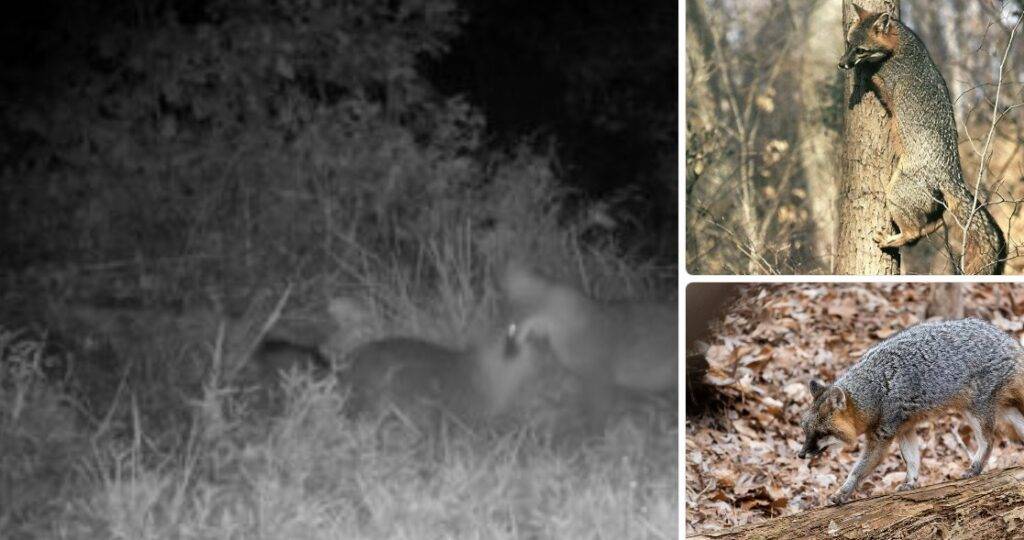Blacksburg, Va. — When scientists suspect a species may be slipping off the ecological radar, they don’t conjure magic — they rig cameras, count tracks and compile data. That’s exactly what researchers at Virginia Tech are doing for the elusive grey fox (scientific name Urocyon cinereoargenteus) in Virginia, part of a new statewide effort to map its population and distribution. Virginia Wildlife Resources+1
Why the grey fox— and why now?
The grey fox is slight compared to its more familiar cousin the red fox: averaging around eight pounds, it sports grizzled gray fur, white underbelly and a hint of reddish tone across its neck and sides. It prowls at dawn and dusk, climbs trees to evade danger, and has earned nicknames like “tree fox” for its arboreal tricks.
In Virginia, sightings of the grey fox have dropped considerably. Data from trappers shows a 97.2 percent decline in pelts over the last two decades, and bow hunters have reported fewer sightings — a 66.1 percent drop in sighting reports. Virginia Wildlife Resources+1
Because published studies on grey foxes in Virginia are scant, the current effort aims to fill that gap. Virginia Outdoors Foundation
The project – cameras, locals, and terrain
This ambitious venture, the Virginia Gray Fox Project (VGFP), is led by Virginia Tech’s Department of Fisheries and Wildlife Conservation and funded by the Virginia Department of Wildlife Resources (DWR). Virginia Wildlife Resources+1
Here’s how they’re doing it:
- In 2024, they placed trail‐cameras at ~425 sites across Virginia’s western region and enlisted ~38 private‐landowner cameras. Virginia Wildlife Resources
- For 2025, their focus shifts to the Piedmont region; 2026 will target the Coastal Plain. Virginia Wildlife Resources
- They hope landowners will either allow cameras on their land or operate their own, following standard protocols so all the data remains comparable. Virginia Outdoors Foundation
- Even when a camera doesn’t capture a grey fox, that absence is data too — it tells researchers where the animal may not be using habitat. Virginia Wildlife Resources

What could be causing the decline?
Researchers point to several possible pressures:
- Loss of early successional habitat (open fields, young forests) and increased urbanization may be eroding the grey fox’s preferred terrain of forest edge and cover. Virginia Wildlife Resources+1
- Competition or direct predation from the expanding population of the coyote, which occupies overlapping prey and territory. Virginia Wildlife Resources+1
- Lower tolerance for urban settings compared with other small carnivores, limiting the grey fox’s ability to adapt to human‐altered landscapes. Virginia Wildlife Resources
- Disease and parasites (for example, canine distemper virus, parvovirus) that could be playing a role but are less well documented. Virginia Wildlife Resources
Why it matters for us
The grey fox isn’t just a sly woodland specter. As a mesocarnivore (a medium‐sized predator), it plays an important role in controlling small mammals, insects and even influencing seed dispersal when it partakes of berries. By understanding its status and distribution, scientists can:
- Track ecosystem health: If an ostensibly common species is declining, it might signal broader habitat changes.
- Inform land management & conservation: Knowing where the grey fox persists (or doesn’t) helps guide woodland preservation, reforestation and corridor efforts.
- Build citizen science engagement: Landowners and wildlife watchers who contribute camera data become part of the research team, turning “private yard” into “wildlife lab.”
- Lay groundwork for studying other elusive species: The camera infrastructure, protocols and partnerships may be extended to animals like spotted skunks, fishers or porcupines. Virginia Wildlife Resources
What you can do— if you’re living in Virginia
If you own or manage land in Virginia and happen to have a trail camera (or are willing to deploy one), the grey fox project invites your participation. Here’s how you can help:
- Contact the VGFP team and ask about how to install and monitor a camera under the project’s protocol.
- If you see a grey fox (photo or sighting), log the date, location and send in the image — even a “zero” (no fox detected) image helps.
- Be a good wildlife steward: secure trash, avoid leaving pet food outdoors, fence rabbit/chicken pens appropriately (grey foxes can climb). These actions help reduce human-wildlife conflict and help maintain healthier ecosystems. Virginia Wildlife Resources
The bottom line
This is a moment of opportunity for the grey fox in Virginia. By shining a light (via trail cameras) into the forest’s dusk, Virginia Tech researchers hope to answer: Are grey foxes in decline? If so, where and why? Their work is not just about one shy fox; it’s about preserving the threads that tie forest, field and human back-yard into one ecological tapestry.
Here’s the link to watch a video about the project for a visual walk-through https://news.vt.edu/videos/k/2025/10/1_j6gcet3y.html
And for more on how to participate on private land, check the Virginia DWR blog post.




How much is going into town councils pockets, and can I get a cut?
Then you sir, are part of the problem in our country.
I do recognize several of the individuals who participated. Many of you are respected members of our community- people who…
To the individuals who drove by my residence repeatedly yesterday, I want to bring something to your attention that you…
Mr. Ford, my apologies. I should have said: Wow, so deep state. Lemme guess, when you're out spouting nonsense, people…